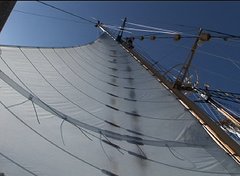
Student Stacy Aguilera counts fish on deck.
We are headed toward the Marquesas with gentle breezes and warm days. The water temperatures are the hottest we've seen, hovering about 85F, and the air temperatures are getting past the 90s. It is remarkably warm- but we're all staying well hydrated and cool with lots of water freshly made by reverse osmosis.
The ocean waters are oligotrophic -- nutrient-poor and a crystal clear. We're in our last days within the South Pacific Gyre, greeted daily by marvelous sunrises and sunsets. We'lll soon be in the Marquesas where two days of intense sampling are planned to examine the Island Mass Effect- examining howthe islands, like rocks in a stream, create vorticity and upwelling in the wake behind the strong west-flowing currents. This creates hot spots with nutrient-rich waters coming to the surface.
Eugene and Ethan will be leading the stations through this region- we anticipate up to 6 stops to sample the physics, nutrients, and biological life in the water column.
During the transit from Rangaroa to NukaHiva, Natalie Arnoldi caught some skipjack tuna for her project, which focuses on the foraging diet of these warm-water predators.
As we're crossing the water column, the carbon and climate research group - led by Jessica Hinojosa, Mara, Reese and Sam - has been getting super Total CO2 and pH in situ. The data coming in are research-grade, and everyone is excited about the opportunity to make such precise measurements that have a bearing on how oceans impact climate.
Soon we'll be at Nuka Hiva- a high pointof our stay in French Polynesia.
-Dr. Barbara Block


2 comments:
Great report, thanks! Here is the link to Captain Phil's Podcast found on the S.E.A. site.
http://www.sea.edu/podcasts/RS_podcasts.asp?podnum=126&filename=RS_05_21_2009.mp3
Marra's name is spelled Marra, fyi
Post a Comment